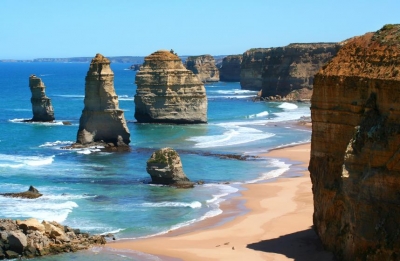
The Twelve Apostles Marine National Park is a protected marine national park located on the south-west coast of Victoria, Australia. The 7,500-hectare (19,000-acre) marine park is situated near Port Campbell and is named after the scenic The Twelve Apostles rock stacks, and contains the wreck of the clipper Loch Ard, wrecked on Mutton Bird Island in 1878. The marine park borders Port Campbell and Great Otway National Parks.
The limestone unit that forms The Twelve Apostles is referred to as the Port Campbell Limestone, which was deposited in the Mid-Late Miocene, around 15 to 5 million years ago.
The Twelve Apostles were formed by erosion. The harsh and extreme weather conditions from the Southern Ocean gradually erode the soft limestone to form caves in the cliffs, which then become arches that eventually collapse, leaving rock stacks up to 50 m (160 ft) high. The stacks are susceptible to further erosion from waves. In July 2005, a 50-metre-tall (160 ft) stack collapsed, leaving seven standing at the Twelve Apostles viewpoint. Due to wave action eroding the cliffs, existing headlands are expected to become new limestone stacks in the future.
The stacks were originally known as the Pinnacles, and the Sow and Pigs (or Sow and Piglets, with Mutton bird Island being the Sow and the smaller rock stacks being the Piglets), as well as the Twelve Apostles. The formation’s name was made official as the Twelve Apostles, despite only ever having had eight stacks.
Credit: Wikipedia
Picture Credit : Google




